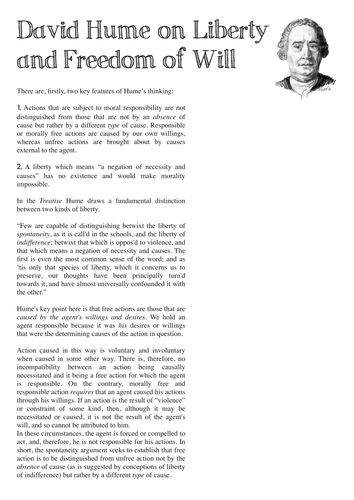
This follows on from my first A2 Compatibilism lesson on the features of Soft Determinist thinking and the form developed by Locke. With this foundation in place and with the appropriate language to hand, I ask students to analyse Hume and draw links between his language and the theory set out by Locke and the locked room thought experiment.
This information is taken in part from the Stanford Encyclopaedia and reformatted to be more easily accessible. plato.stanford.edu/entries/hume-freewill/
If you're struggling, the answers I give to the three types of liberty are as follows:
Liberty of Indifference: Being to choose against your will.
Liberty of Spontaneity: Being able to carry out your will unconstrained.
Hypothetical Liberty: Having a number of valid different options that you may or may not will to do and can do.
The previous lesson is available for sale here:
https://www.tes.com/teaching-resource/as-a2-compatibilism-soft-determinism-11124715
This information is taken in part from the Stanford Encyclopaedia and reformatted to be more easily accessible. plato.stanford.edu/entries/hume-freewill/
If you're struggling, the answers I give to the three types of liberty are as follows:
Liberty of Indifference: Being to choose against your will.
Liberty of Spontaneity: Being able to carry out your will unconstrained.
Hypothetical Liberty: Having a number of valid different options that you may or may not will to do and can do.
The previous lesson is available for sale here:
https://www.tes.com/teaching-resource/as-a2-compatibilism-soft-determinism-11124715
Something went wrong, please try again later.
This resource hasn't been reviewed yet
To ensure quality for our reviews, only customers who have downloaded this resource can review it
Report this resourceto let us know if it violates our terms and conditions.
Our customer service team will review your report and will be in touch.
£0.00
